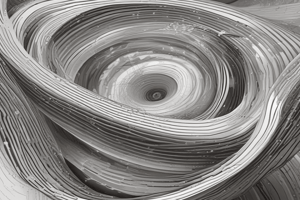Podcast
Questions and Answers
What is the pressure at a depth of 150 meters?
What is the pressure at a depth of 150 meters?
- 2 Bars
- 2.5 Bars (correct)
- 3 Bars
- 1.5 Bars
If the volume of a balloon at the surface (1 Bar) is 4 L, what would be its volume at a depth of 200 meters?
If the volume of a balloon at the surface (1 Bar) is 4 L, what would be its volume at a depth of 200 meters?
- 2 L (correct)
- 1.33 L
- 0.75 L
- 1 L
What is the density of air at 300 meters depth?
What is the density of air at 300 meters depth?
- 2.5 kg/L
- 3 kg/L
- 5 kg/L
- 4 kg/L (correct)
What volume of water would displace a buoyant force of 1.85 kg at 100 meters depth?
What volume of water would displace a buoyant force of 1.85 kg at 100 meters depth?
Which statement about the relationship between pressure and volume is correct?
Which statement about the relationship between pressure and volume is correct?
At a depth of 66 feet, how much atmospheric pressure does a diver experience?
At a depth of 66 feet, how much atmospheric pressure does a diver experience?
How much air does a diver use at a depth of 66 feet compared to the surface?
How much air does a diver use at a depth of 66 feet compared to the surface?
What happens to the volume of air in a diver's lungs when they descend to a depth of 33 feet?
What happens to the volume of air in a diver's lungs when they descend to a depth of 33 feet?
If a diver descends to 30 meters (approximately 98 feet), what will happen to their 1 liter of air when it compresses?
If a diver descends to 30 meters (approximately 98 feet), what will happen to their 1 liter of air when it compresses?
What are some potential effects on a diver due to increased water pressure at depth?
What are some potential effects on a diver due to increased water pressure at depth?
Flashcards are hidden until you start studying
Study Notes
Water Pressure
- The absolute pressure at the surface is P0, and it increases by 1 Bar for every 10 meters of depth.
- The volume of water remains constant at 1 L for every depth, and the density remains the same at 1 kg/L.
Boyle's Law
- PV = constant
- n, the number of moles, remains constant, making the quantity of water constant.
Gas Compression
- As pressure increases, volume decreases.
- Density stays the same for every depth.
- According to Boyle's Law, PV = constant, and n, the number of moles, remains constant.
Balloon Example
- A 4 L balloon filled with 3.7 L of air is affected by pressure changes at different depths.
- At 100m, the pressure is 2 Bars, and the volume is 1.85 L.
- At 200m, the pressure is 3 Bars, and the volume is 1.23 L.
- At 300m, the pressure is 4 Bars, and the volume is 0.93 L.
- At 400m, the pressure is 5 Bars, and the volume is 0.74 L.
Buoyancy
- A buoyant object will float to the surface, but will sink if anchored or tied to a weight.
- Buoyancy force can be calculated based on the volume of the object.
Diving
- Increased water pressure affects the body, requiring divers to deal with the pressure.
- As you descend, air volume decreases, and pressure increases by 1 atmosphere every 10 meters or 33 feet.
- This means that at 33 feet, you will experience twice the weight of the atmosphere, equivalent to two cars on top of you.
Air Volume and Density
- Water does not compress, but air does, causing the volume of air to decrease with depth.
- As you descend, air compresses until it reaches a point where it doesn't compress anymore.
- Air will always change its volume according to the surrounding pressure.
Diving Risks
- If you don't equalize your ears, you might experience discomfort and injury due to the pressure change.
- The deeper you go, the more pressure on your lungs, requiring deeper breathing to get the same amount of oxygen.
- This affects air supply, causing you to exhaust your air supply quicker.
- You will use 113% of air for a 33-foot descent, and 125% for another 33-foot descent.
Studying That Suits You
Use AI to generate personalized quizzes and flashcards to suit your learning preferences.





